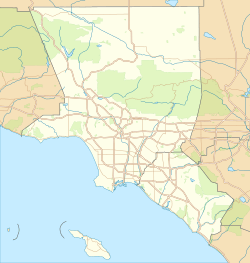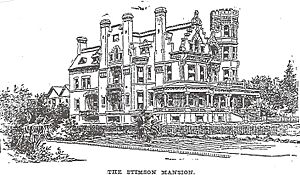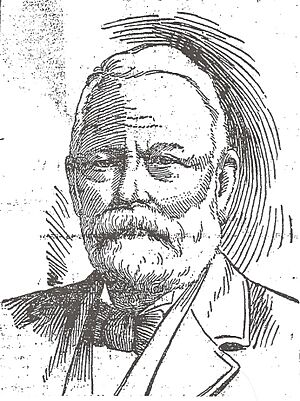Stimson House facts for kids
|
Stimson House
|
|
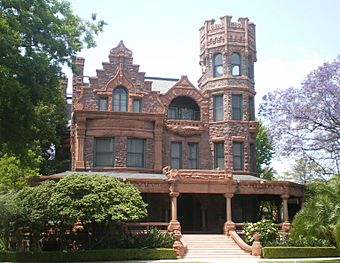
Stimson House, 2008
|
|
| Location | 2421 S Figueroa Street Los Angeles, California |
|---|---|
| Built | 1891 |
| Architect | Carroll H. Brown, E.D. Elliot |
| Architectural style | Richardsonian Romanesque, Gothic Revival |
| NRHP reference No. | 78000690 |
Quick facts for kids Significant dates |
|
| Added to NRHP | March 30, 1978 |
The Stimson House is a grand mansion in the University Park area of Los Angeles. It was built in 1891 and was once the home of Thomas Douglas Stimson, a very rich man who made his money in lumber and banking. During his time, the house even survived a strange attack in 1896.
After Stimson passed away, the house had many different owners. It was home to a brewer, a noisy college fraternity, students from Mount St. Mary's College, and even a convent for the Sisters of St. Joseph of Carondelet.
Contents
About the House's Design
A Famous Los Angeles Building
When the Stimson House was first built in the 1890s, the Los Angeles Times newspaper called it "the most expensive and beautiful private home in Los Angeles." They said it was a building "admired by all who see it."
More than a hundred years later, the Times still described it as amazing. They said the 3.5-story house looks like a medieval castle from the front. It has brick chimneys that stand tall like guards on the roof. There's also a fancy four-story tower on one corner, like a tall piece from a giant chess board.
The house cost $150,000 to build, which was a huge amount of money back then. It was the most expensive house ever built in Los Angeles at that time. From the day it was finished, this 30-room house became a famous landmark in Los Angeles. People often called it "the Castle" or the "Red Castle" because of its tall walls, four-story tower, and red stone outside.
Outside Features
Thomas Douglas Stimson hired a young architect named H. Carroll Brown to design his new home. Brown designed the house mostly in the Richardsonian Romanesque style. This style uses rough stone, rounded arches, and a strong, fortress-like look.
The red stones for the house came from a quarry in New Mexico. San Fernando sandstone was used for the windows, balconies, and the top of the tower. The most striking part of the house is its four-story Gothic tower. The very top of the tower has notched battlements, like a castle. Other cool features include a third-floor balcony and a porch with carved stone columns around the first floor.
The area where Stimson House was built was known as "Millionaires Row" in the 1890s. Even among other large homes, the Stimson House stood out because of its size and strong stone construction.
Inside Features
It might seem strange that a lumber millionaire built a stone house instead of a wooden one. However, the inside of the Stimson House is like a museum of wood! It features many different types of wood, such as ash, sycamore, birch, mahogany, walnut, gumwood, and oak. All this wood was brought from lumber yards in the Midwest.
Each room on the first floor uses a different type of wood. The heavy doors are extra thick to match the wood in the rooms on both sides. The oak floors throughout the house have a detailed parquet pattern around their edges.
Below the first floor is a basement with many rooms and arched doorways. There was even a hidden safe in Stimson's study. Later, the nuns who lived there used it to store cleaning supplies!
History of the Stimson House
Thomas Douglas Stimson
Thomas Douglas Stimson (1827–1898) was one of the richest people in Los Angeles. He was a self-made man, meaning he became successful on his own. He left home at 14 and worked as a trader. Later, he built a very successful lumber business in Chicago.
In 1890, at age 63, he moved to Los Angeles. He was looking for a nicer climate for his retirement. But instead of retiring, Stimson became very active in the Los Angeles business world. He was a major owner in Citizens Banks and was vice president of the Los Angeles Chamber of Commerce.
In 1893, Stimson hired the same architect, H. Carroll Brown, to build the Stimson Block. This was a six-story office building downtown. It had many of the same design features as Stimson House. When it opened, the Stimson Block was the tallest building in Los Angeles. Sadly, it was torn down in 1963 for a parking lot.
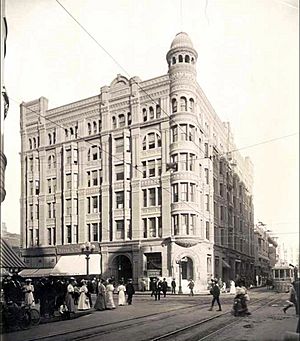
Stimson died at Stimson House in February 1898. His wife, Achsah, lived in the house until she passed away in 1904.
A Strange Attack
In February 1896, the Stimson House was the target of a very strange attack. The newspaper headline read, "DYNAMITE FIENDS: An Attempt to Blow Up the Stimson Mansion." Someone placed an explosive device against the house's foundation, right under Stimson's bedroom.
The explosion tore a large hole in the side of the house. However, the very thick foundation wall was not damaged. Reports said that a wooden house would have been destroyed, but the strong stone structure survived the blast. Neighbors saw a man run away after the explosion and fired shots, but he escaped.
Later that month, a private detective named Harry Coyne was arrested for the attack. It turned out that Coyne had been trying to trick Stimson. He pretended that a criminal was after Stimson and offered his help. Coyne even claimed the criminal had poisoned Stimson's dog. After the explosion, Coyne suggested he could "take care" of the problem. Stimson realized it was a trick by Coyne. Coyne was eventually found guilty and sent to prison.
Edward Maier and Fraternity Fun
After Stimson's wife died, the house was sold. In 1918, Edward R. Maier, who owned a brewing company, bought the house. He lived there until 1940.
In 1940, the Maier family sold the house to the USC's Pi Kappa Alpha fraternity. They bought it for $20,000, much less than it cost to build! The fraternity members called the house the "Red Castle."
The fraternity house was known for its lively parties. One time, students from a UCLA fraternity played a prank on USC. In response, USC students captured two UCLA students and brought them to Stimson House. They were held in the basement, which the fraternity brothers called the "catacombs." The USC students played pranks on them, like painting "S.C." on their chests.
Years later, when the fraternity brothers had a reunion at the house, they remembered their time there. They recalled locking new members in the basement and spraying them with a hose. One member even proposed to his wife on the house's stairs!
A Convent for Nuns
The property behind Stimson House belonged to Carrie Estelle Doheny. She was the widow of a rich oil man, Edward L. Doheny. Mrs. Doheny had grown up nearby and remembered seeing the Stimson House being built.
For eight years, from 1940 to 1948, Mrs. Doheny lived behind the noisy fraternity house. The loud parties were a constant problem for her. She often complained to the university president. By 1948, Mrs. Doheny had enough. She offered $75,000 to buy the house from the fraternity. The fraternity was already finding it hard to pay for the big house, so they accepted her offer.
After buying the house, Mrs. Doheny made sure she wouldn't have noisy neighbors anymore. She gave Stimson House to the Sisters of St. Joseph of Carondelet to use as a convent. The Los Angeles Times wrote that the house, once filled with parties, would now be a quiet chapel for prayers.
The Sisters of St. Joseph used the house as a convent from 1948 to 1969. From 1969 to 1993, it was used as housing for students at Mount St. Mary's College. In 1993, the sisters returned and continued to use it as a convent.
Earthquake Damage
The Stimson House was badly damaged in the 1994 Northridge earthquake. Bricks fell through the roof, and the chimney, walls, and tower were also damaged. The Sisters of St. Joseph had just moved back in, but they had to leave for ten months while repairs were made.
A Historic Building
The Stimson House was added to the National Register of Historic Places in 1978. It has also been named a Historic-Cultural Monument by the City of Los Angeles. In 1977, experts called it "architecturally unique in Los Angeles" and "one of the most significant structures in the Los Angeles area."
Seen on Screen
The Stimson House has been used as a location for many commercials, TV shows, and movies, including:
- It appeared in the films House II and After Midnight.
- It was seen in the mini-series Captains and Kings and Testimony of Two Men.
- An episode of The Bionic Woman filmed there, with a stunt double jumping from a second-floor porch.
- It was used as a mortuary in an episode of Pushing Daisies.
- The outside of the house was used in seasons five, six, and seven of Mad Men.
- It appeared in an episode of the TV show Legion as an early version of the X-Mansion.


